- Astrology
- Auras
- Beltane
- Breathwork
- Candle magick
- Card spreads
- Cassie Uhl
- Chakras
- Cleansing
- Crystals
- Dark moon
- Death Care
- Divination
- DIY
- Dreams
- Elements
- Empath
- Energy work
- Free download
- Full moon
- Goddess
- Grief
- Handmade
- Herbs
- How-to
- Imbolc
- Intuition
- Journaling
- Letting go
- Litha
- Lughnasadh
- Mabon
- Magic
- Mantras
- Meditation
- Moon phases
- Mudras
- New moon
- Numerology
- Oracle
- Ostara
- Palmistry
- Plant Allies
- ritual
- Rituals
- Runes
- Sacred geometry
- Samhain
- Seasonal magick
- Shadow work
- Spellwork
- Symbolism
- Tarot
- The Ritual Deck
- Waning moon
- Waxing moon
- Wellness
- Wheel of the Year
- Winter Solstice
- Witchcraft
- Yoga
- Yule
- Zodiac
- air
- apple magic
- apples
- aquarius
- aquarius card spread
- aquarius ritual
- aquarius season
- aries
- astrology
- aura protection
- auras
- autumn equinox
- beltane
- cancer
- cancer season
- candle dressing
- candle magic
- candle magick
- capricorn
- card spread
- cast a circle
- casting circles
- cauldron
- Ceres
- chakra energy
- chakras
- channeling
- charging
- cleansing
- correspondences
- creosote
- Creosote
- crone
- crystal healing
- crystals
- death doula
- death positivity
- death work
- Demeter
- divination
- diy
- dream ritual
- dream rituals
- dream work
- dreams
- dreamwork
- eam
- earth
- eggs
- elements
- emotion code
- empath
- energy
- energy cleansing
- energy protection
- energy work
- fall equinox
- feeling auras
- fire
- four elements
- free meditation
- full moon
- full moon energy
- full moon in gemini
- full moon in pisces ritual
- full moon in scorpio eclipse
- full moon ritual
- gemini
- gemini card spread
- gemini season
- goddess
- grandmothers
- gratitude
- Great mother
- grief
- grief tending
- harvest season
- heart chakra
- herbal magic
- herbal magick
- herbal magick 101
- herbs
- high priestess
- house cleansing
- imbolc
- improving intuition
- infertility
- infertility awareness
- intuition
- intuitive healing
- jen isabel friend
- kunzite
- lammas
- learning tarot
- leo
- leo season
- letting go
- libra
- libra season
- lughnasadh
- Lulu Tineo
- mabon
- manifesting
- meditation
- moon phases
- mother meditation
- mother's day
- new moon
- new moon card spread
- new moon in capricorn
- new moon in leo
- new moon in libra
- new moon meditation
- new moon ritual
- north
- nurturing mother
- oracle
- oracle card spread
- ostara
- pendulum
- pendulums
- Persephone
- pineal gland
- pisces
- pisces full moon ritual
- plant connection meditation
- Plant magic
- popular
- protection magic
- protection magick
- reiki
- releasing
- residual energy
- resiliency
- ritual
- samhain
- scorpio
- scorpio season
- scrying
- seasonal magic
- seeing auras
- shadow work
- shamanic healing
- sigil
- smoke wands
- spell bottle
- spellwork
- Spirits
- spiritual
- spring equinox
- tarot
- tarot myths
- taurus
- taurus season
- the four elements
- third eye
- triple goddess
- understanding the earth element
- virgo
- waning moon
- water
- water is life
- waxing moon
- what are death doulas
- wheel of the year
- winter
- winter solstice
- witch bells
- working with auras
- Yolia Botanica
- yule
- zodiac
How to Dress a Candle for Spellwork
Candles are included in spellwork, and there’s a reason why. Fire magic is powerful — it can help transform energy, focus your desires, send intentions into the universe, burn away what you want to release, and more.Candles are powerful on their own, but dressing a candle for spellwork can help amplify and intensify your spell.

Candles are included in spellwork, and there’s a reason why. Fire magic is powerful — it can help transform energy, focus your desires, send intentions into the universe, burn away what you want to release, and more.
Candles are powerful on their own, but dressing a candle for spellwork can help amplify and intensify your spell. In this blog post, I’ll be breaking down how to dress a candle for spellwork. To get more of an intro to candle magick, check out this blog post.

WHY DRESS A CANDLE FOR SPELLWORK?
Dressing a candle spellwork can mean rubbing a candle in oil and/or rolling a candle in herbs. Using herbs and oils that support the intention you’re working with can help you amplify your spell, making it more powerful.
Below, I share some correspondences for oils and herbs to help you decide how to dress your candles most effectively.
HOW TO DRESS A CANDLE FOR SPELLWORK
Here are some loose guidelines for dressing your candles for spellwork:
1. Cleanse your candle. You can cleanse your candle with salt, smoke, sound, or any other cleansing tool that feels good to you.
2. Rub your candle in oil. As you do, focus on the intention of your spell.
3. Roll your oiled candle in herbs if you’re using them. Again, direct your energy towards your spell’s intention as you roll your candle. Stay present, breathe, and focus on connecting your intention to your candle.
OILS, HERBS & CORRESPONDENCES FOR CANDLE MAGICK
Before I get into correspondences, a note about oils: you can feel free to use neutral oils like sunflower seed oil or coconut oil. When you work these oils, they act more as a vehicle for your herbs than an intention amplifier on their own.

Explore the Radical Candle Magic class.
If you want to use an oil that brings its own amplifying qualities, you’ll be using essential oils. If you decide to use essential oils, I invite you to be really intentional with them, buy small amounts only, and research as much as you can to find companies that are making them in the most sustainable and ethical ways possible. The same goes for herbs - do your research and make sure you’re gathering any herbs you use ethically.

Featured deck is The Ritual Deck.
For pleasure spells - Use red or orange candle colors. Use clary sage, lavender, or sandalwood oil with rose petals or other flower petals, ginger, or calendula.
For abundance spells - Use green, brown, or gold candle colors. Use basil, cinnamon, or frankincense oil with cinnamon, basil, or ginger.
For creativity spells - Use orange, yellow, blue, or purple candle colors. Use tangerine or peppermint oil with verbena, bay leaves, or angelica.
For intuition spells - Use blue, purple, or silver candle colors. Use myrrh, or clary sage oil with mugwort, chamomile, or rose petals.
For protection spells - Use brown, black, or blue candle colors. Use clove, cypress, or juniper oil with mugwort, mullen, or comfrey.
For releasing spells - Use yellow, orange, or black candle colors. Use bergamot or geranium oil with cloves or rosemary.
For love spells - Use red, orange, or pink candle colors. Use cardamom, jasmine or ylang-ylang oil with yarrow, oregano, or fennel.
Want more on spellwork? Check out these blogs:
Dreamwork 101 // What is Dreamwork and How to Get Started in 5 Steps
Dreamwork is the practice of tending to our relationship with our dreams. We’re dreaming every night, but many of us barely remember our dreams, or if we do, don’t spend much time thinking about them or working with them.(How often have you dismissed a dream as, “oh, it was just a dream?”)

Dreamwork is the practice of tending to our relationship with our dreams. We’re dreaming every night, but many of us barely remember our dreams, or if we do, don’t spend much time thinking about them or working with them.
(How often have you dismissed a dream as, “oh, it was just a dream?”)
But dreams can have a lot to teach us and offer us when we enter into a deeper relationship with them. The dreamworld is rich with feelings, desires, needs, and possibilities. Our understanding of what the dreamworld evokes and presents can support our physical lives and our connections to ourselves.
In this blog post, I’ll share a bit about how to start a dreamwork practice of your own.
Dreamwork Lineage
First, I’d like to share my dreamwork lineage. What I know about dreamwork comes from the work of these folks in particular, as well as my own intuition and my ancestors:
These are wonderful people to go deeper into dreamwork with if you feel so called.
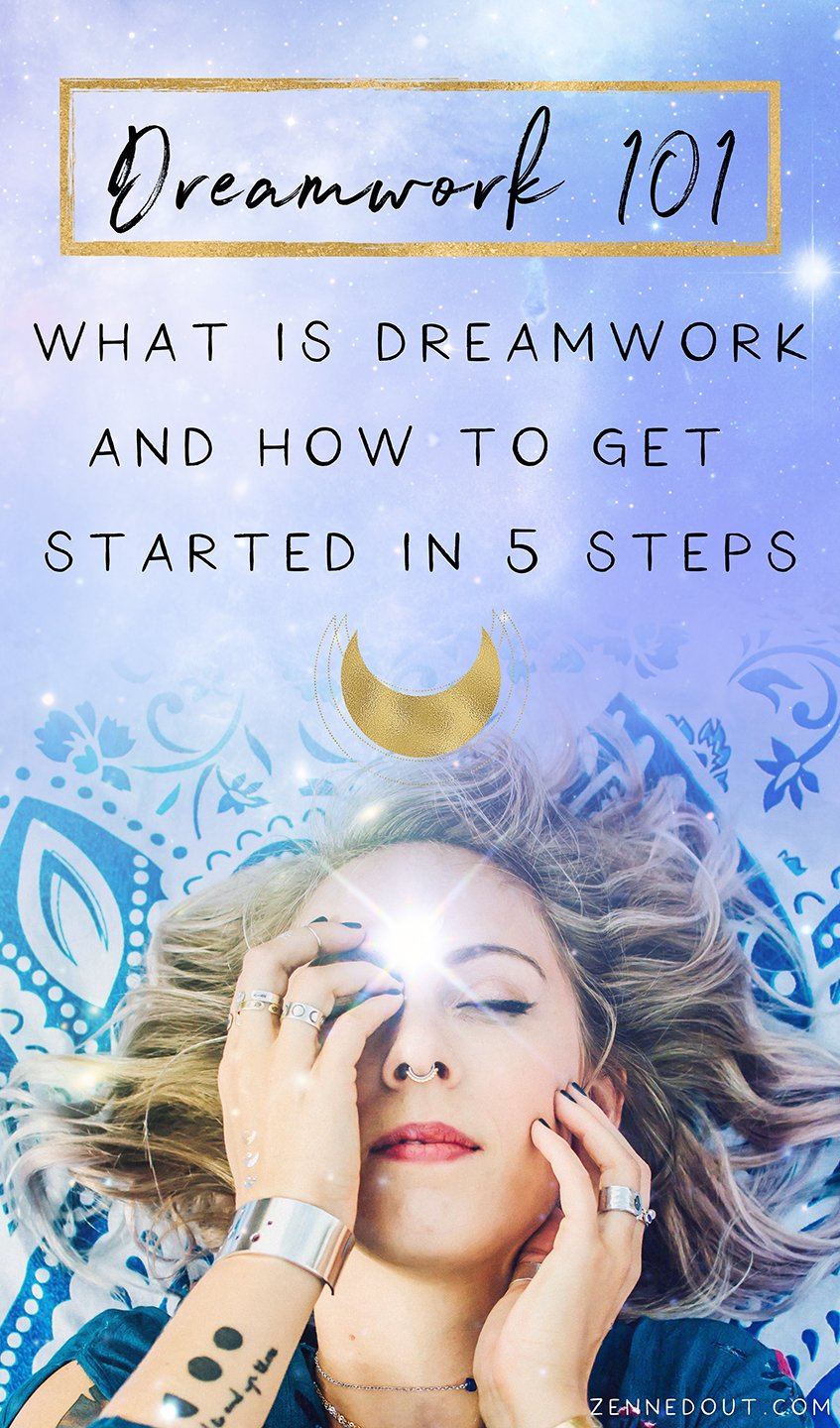
1. Support Dream Recall + Sleep
The simplest of ways to begin supporting your dreaming is by supporting sleep and dream recall. It’s difficult to consciously work with our dreams if we’re not sleeping well or can’t remember our dreams when we wake up. Everyone is different, but here are some things you might like to explore to support your sleep:
Set screen time boundaries for a certain amount of time before bed
Drink a tea to support your sleep, like chamomile (always do your own research and check with a professional before ingesting herbs)
Create your own sleep ritual that helps you shift into rest mode
Meditate and/or do a gentle, restorative yoga practice
Take a few minutes to journal brain-dump style to help clear your mind.
To support your dream recall, there are a few things I find helpful:
Set an intention to dream and to remember your dream(s) before you go to sleep (you can write this down, say it out loud, or just tell it to yourself silently)
Take a few minutes in bed in the morning before you get out of bed (or look at your phone) to give yourself space to remember your dream.
Create a dream altar and meditate at it before bed to welcome your dreams to come
Pay attention to the dreams you do receive by tending them (more on that below!)

2. Start a Dream Journal
This is probably the number one tip anyone you ask about dreamwork will give you, and with good reason! A dream journal creates a container for tending your dreams, helps solidify your intention to connect with your dreams, and helps you understand your dreams.
I recommend choosing a dedicated journal for your dreamwork and placing it on your dream altar when you’re not using it if you have one. As soon as you wake up (definitely before you look at any devices), put pen to paper and record your dream. Try recording your dreams in the present tense to honor its aliveness (for example, instead of "I was walking by a river,” try “I’m walking by a river).
If it feels available to you, you might like to marinate in the dream in bed for a few minutes before actually getting up and reaching for your journal to record.
3. Explore Dream Feelings & Textures
After you record your dream, there are many ways to work with it more deeply and explore the messages it might have for you.
I like to explore the dream textures: what are the textures, sights, smells, tastes, sounds of the dream? What do those senses mean for you and evoke for you? How do they make you feel? How does the dream, in general, make you feel?
4. Understand Dream Associations
As you work with the dream you’ve recorded, notice what stands out to you. Maybe your red dress feels particularly alive, or the hawk sparks something for you, or you feel curious about a figure in your dream.
Whatever you feel curious about, do a bit of freewriting about it. List out: what does this thing make you think of? How does it make you feel?
For example, some associations that come up with hawks for me:
Hawk feather
Maggie Smith’s poetry book Good Bones
Mothers
Protecting your children
Imagination
Play
Notice how I’m not so focused on the hawk itself, but I follow the threads of what each thing is associated with! Now I have something interesting to work with and can ask myself questions like, "what’s my relationship with play right now?"
Some of the associations you make might really surprise you and can offer deeper insight into your dream.
5. Assign Dream Correspondences
As you continue to work with your dreams, you start to develop some personal symbols and correspondences.
Like you saw above in my example with the hawk, I could make a section in my journal where I note that hawk led me to mothers and children and play. When I see a hawk again in my dream, I have that reference and can ask myself if/how it applies to this dream.
Over time, you can deepen your understanding of your own personal dream symbols and correspondences. I love this practice so much because, to me, it’s not about what a certain symbol means but about what it means to you, how it feels in your body, how it resonates with your ancestry. That’s what feels potent and powerful!
Dreams Aren’t Your Personal Vending Machine
It feels important to state that working with dreams isn’t just asking a question and receiving an answer. Generally, it’s not a simple or linear way of working. There isn’t one true or hidden meaning that we need to uncover.
In my eyes, dreams and the dreamworld are alive. So it truly is a practice of engaging in relationship with, of exploring. You might like to ask yourself, "how can I be in equal exchange with my dreams?" How can I honor the dream world and not just extract from it?
Dreams have such potential to expand us out of binary thinking and into visionary possibilities, especially if we acknowledge that power and allow them to take us there!
Going Deeper with Your Dreams
Another way to explore dream tending and go a bit deeper is by asking for a dream. I share how to do this in the dreamwork ritual I shared for Pisces season, which you can find here.
Feel free to contact us and share: how is your dream practice going? How is your relationship with your dreams evolving?
Dreamwork Ritual for Pisces Season + Card Spread
Pisces, our mutable water sign and last sign of the zodiac, evokes the artist, the mystic, the dreamer, in all of us with its connection to music, poetry, spirituality, and the dream world.In this blog post, I’ll be sharing a card spread and a ritual for Pisces season.
Sinking into acceptance // 4 Rituals for the Waning Moon + Card Spread
The waning moon phase is nature's way of calling you inward. How can you truly know what you need to release, shed, or let go of if you haven't allowed yourself time to go inward and fully experience your emotions? This phase is your invitation to feel and allow.The waning moon phases occur after the peak of the full moon to the dark moon. Energetically this phase represents a time of allowance, acceptance, and shedding.
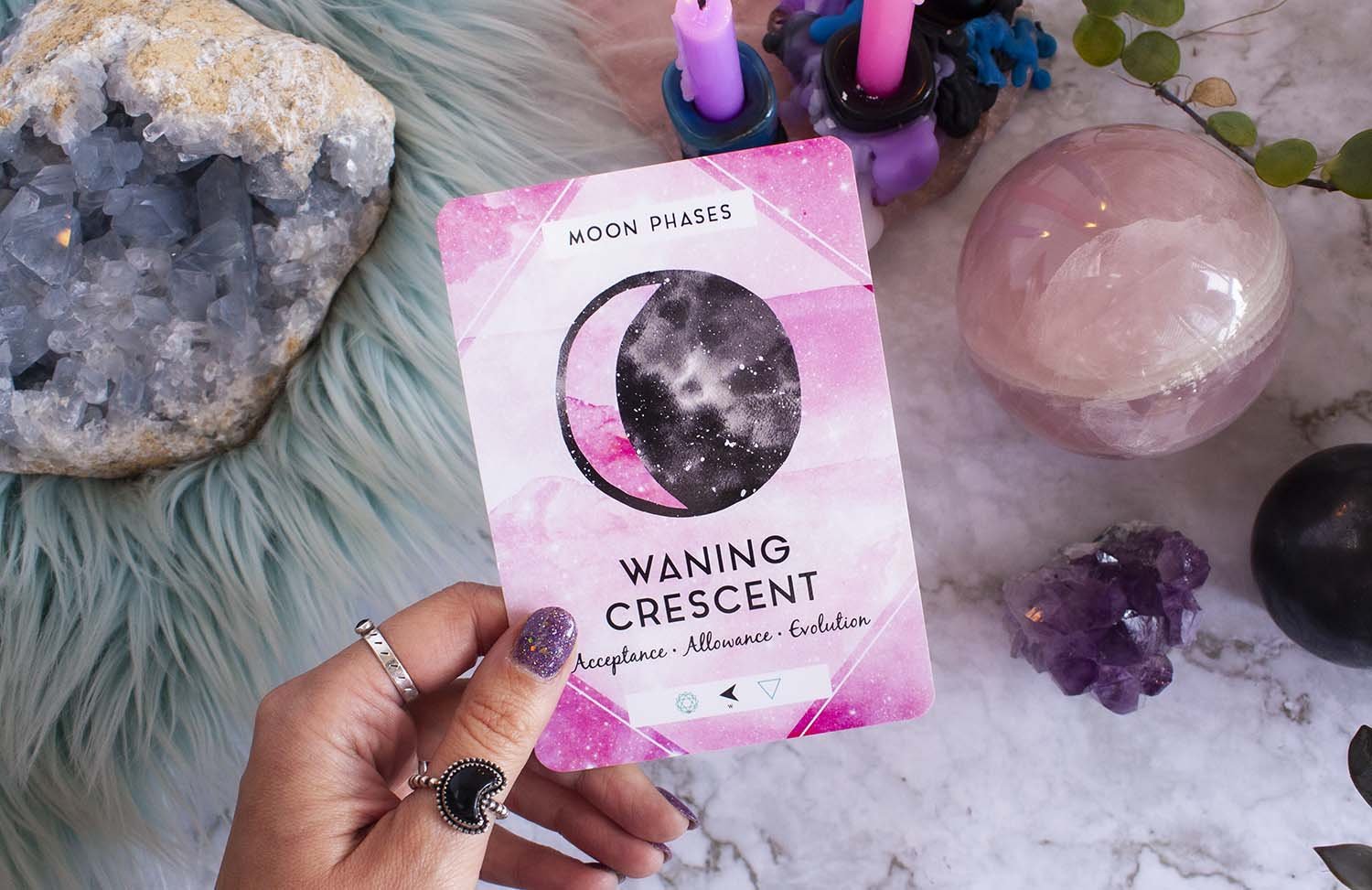
The waning moon phase is nature's way of calling you inward. How can you truly know what you need to release, shed, or let go of if you haven't allowed yourself time to go inward and fully experience your emotions? This phase is your invitation to feel and allow.
The waning moon phases occur after the peak of the full moon to the dark moon. Energetically this phase represents a time of allowance, acceptance, and shedding.
Growing up, most of us are taught to bottle our feelings up rather than sinking into them and accepting what is. Acceptance doesn't mean rolling over and taking it or being okay with the status quo. Not by a long shot. Acceptance of the current moment means allowing yourself to fully experience whatever is bubbling up in you at the present moment.
If things in your life, or the world at large, are not aligned with your desires and want them to change, you don't have to accept them as they are. What you do need to accept is your feelings about these situations. It's in the allowance and acceptance of situations that healing, growth, and change can occur.
There's an opportunity to grow from every situation you're presented with, and this phase asks you to be open to the learning and evolving process rather than pushing against it. Imagine the energy of this lunar cycle as a big unconditional and loving hug.

Here are a few keywords to understand the basic energy of this lunar phase.
Energetic Themes for the Waning Moon
Passiveness
Acceptance
Allowance
Releasing
Shedding
Resting
The rituals outlined below will work well together, but if you don't have the time or tools to perform all of them at once, that's okay, do what feels most aligned with your needs. Keep reading for four ritual suggestions for the waning moon phase.
1. Candle Ritual for the Waning Moon
Candles are an ideal ritual tool for this moon phase because they can be used as a very passive tool. I suggest using this candle ritual suggestion in tandem with one of the ritual suggestions below so your candle can burn as you sink into a ritual. There's more than one candle color that will work for this lunar phase, here are three suggestions, go with what feels best for where you're at, or use all three!
Pink candle: Pink candles offer soft and loving energy. This candle color is ideal for bringing in self-love and acceptance. This candle color is often suggested during the waxing moon phase to call in romantic love. For the waning moon phase, its energy will be used as a tool to call in self-love.
Blue Candle: Blue candles offer peace and respite. If you've been in a cycle of overwhelm and feel like you can't catch a break, this is your candle. The energy of this candle can help you soften into the present moment to access your emotions better.
Purple Candle: Purple candles offer inner wisdom and perspective. If you're in a place of allowance with your emotions but struggling with accepting them, the energy of a purple candle can help open you up to a higher perspective and shed light on why you feel the way you do.
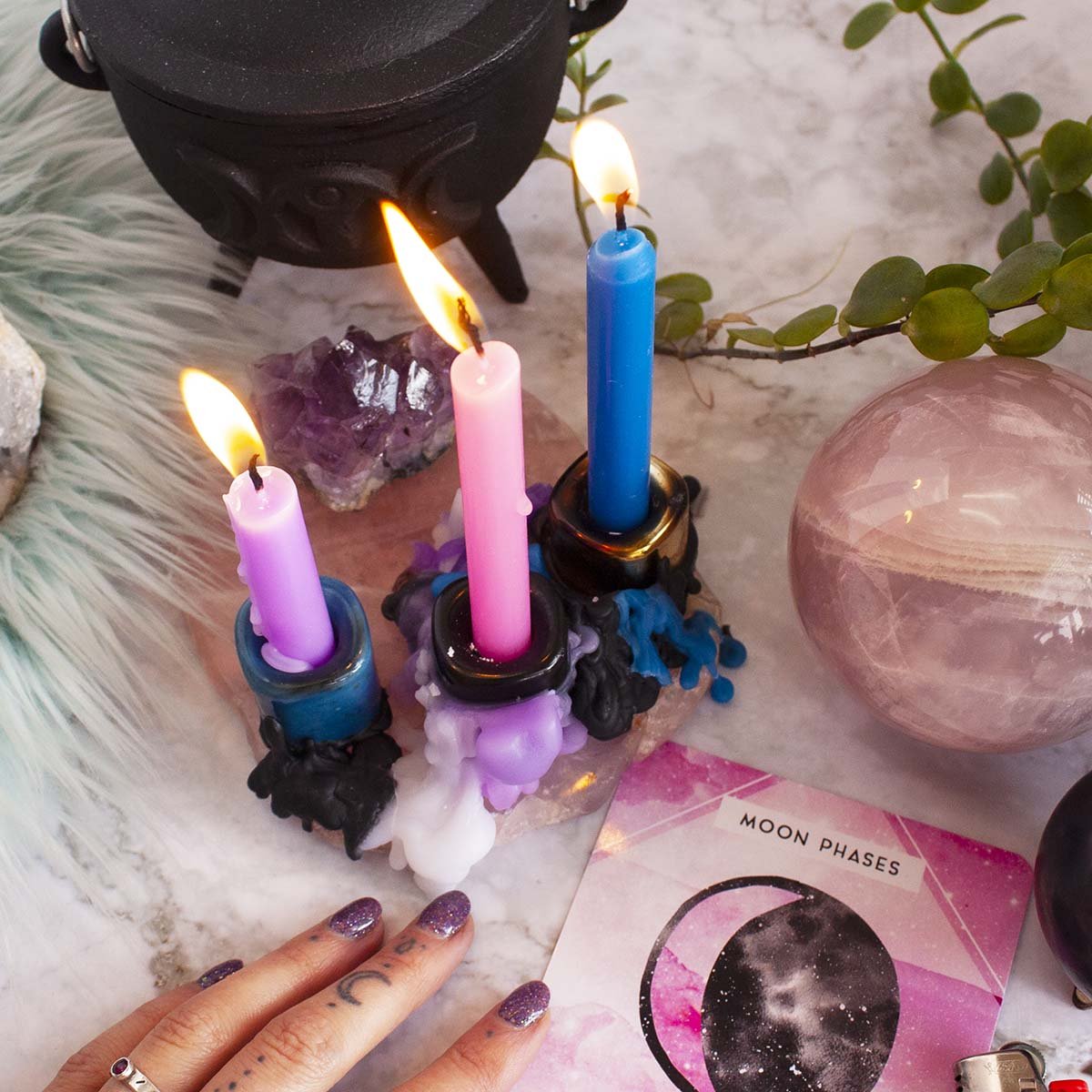
If candle magick is new to you, and you'd like to learn more about how it works and the process I outline here, check out this past blog post on candle magick basics.
Once you've selected your candle color(s), you may want to anoint your candle with a specific oil. I suggest lavender, bergamot, rose, or geranium work well with the energy of the waning moon. If you don't have any of these available, a simple carrier oil, like almond or coconut oil, will work just fine.
Anoint your candle with your oil, hold it in your hands, and impress it with your energy. Repeat this intention or something like it that feels good to you, "I love and accept myself as I am. I am allowed to feel the fullness of my emotions and will let them flow through me. I trust that Spirit will show me what needs to stay and what needs to go. So it is."Light your candle(s) and stay with it as it burns.
2. Waning Moon Meditation
If you're going to do any of these waning moon rituals, meditation is my top suggestion. I covered this topic in-depth in a previous post, so I'm not going to spend too much time discussing it here. But, if you've followed me for long, you know that I adore meditation.
Meditation opens you up to your inner world, which is step one in allowance and acceptance. As I said above, you have to take the time to explore your inner landscape before you can truly know what needs to be released. Meditation and internal reflection is the first step in this process.
Click here to get my free waning moon meditation or here to read my previous blog post on meditating with each moon phase.
If you'd like to add some supportive crystals to your waning moon meditation, I suggest rose quartz and a grounding stone of choice like obsidian, black tourmaline, or garnet.
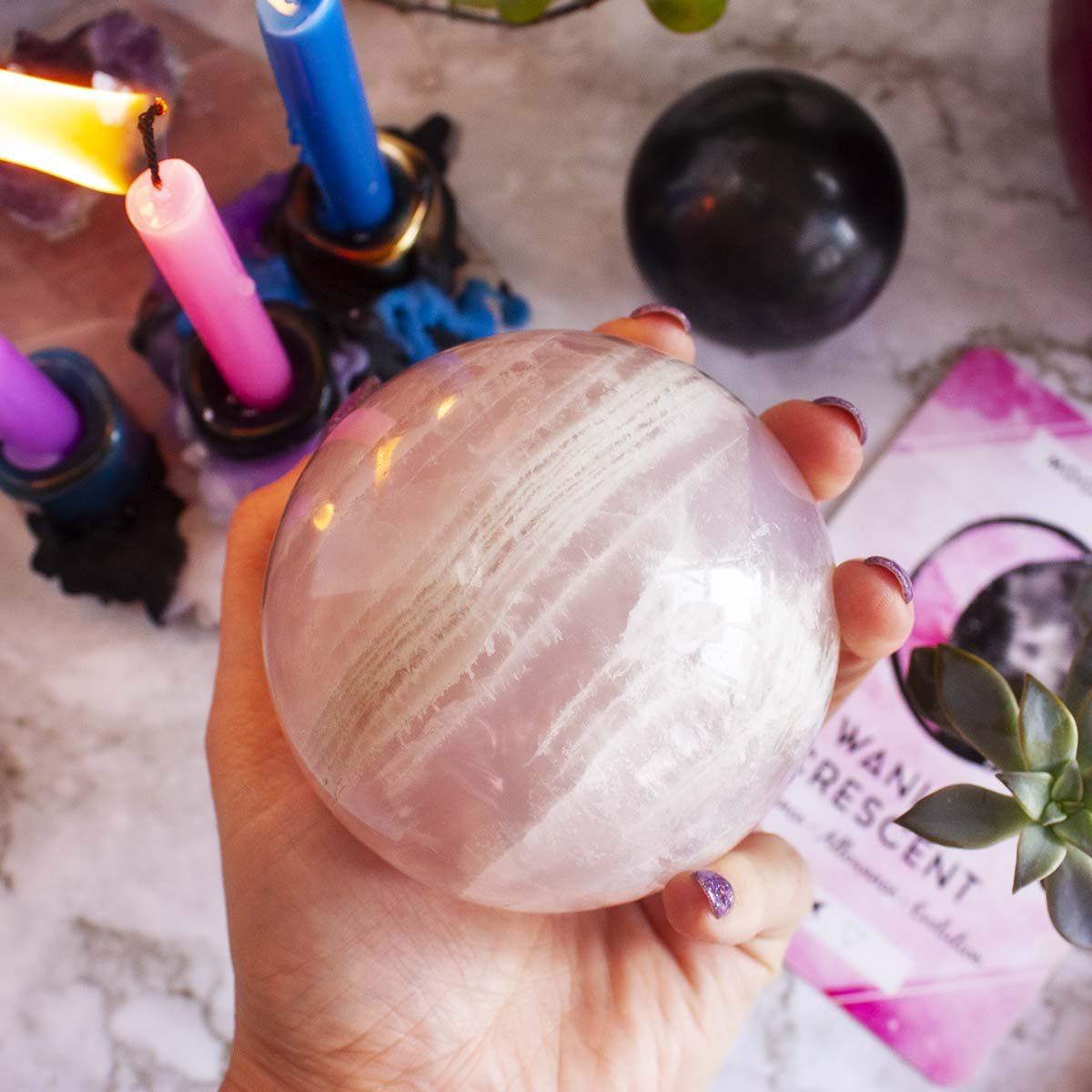
3. Waning Moon Card Spread
Use this card spread with your favorite oracle or tarot card deck. These questions can offer guidance on finding more acceptance in your life and suggestions for releasing anything holding you back from your highest good.
If you didn't begin with the candle ritual or meditation suggestion above, take a moment to connect with your breath and ground yourself.
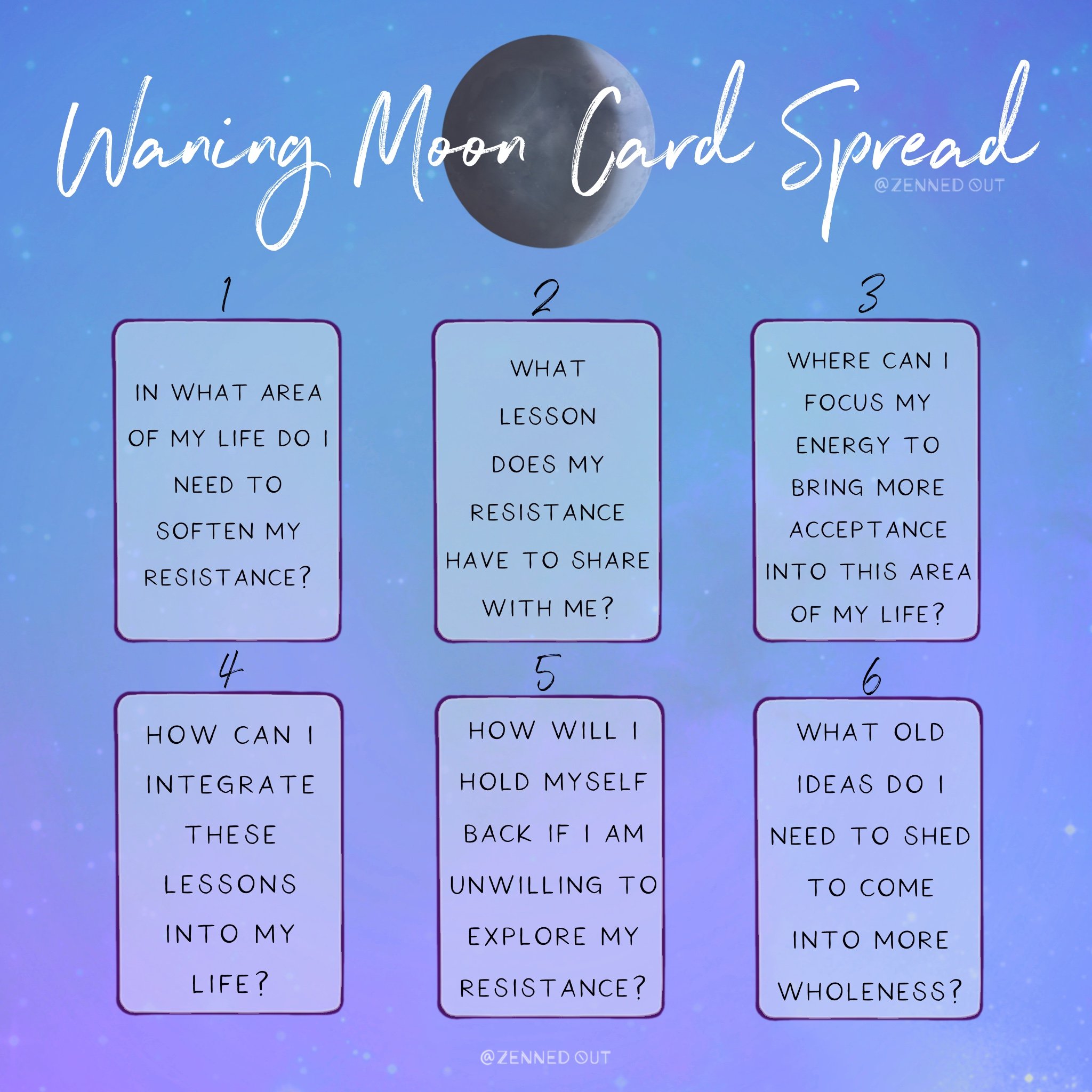
In what area of my life do I need to soften my resistance?
What lesson does my resistance have to share with me?
Where can I focus my energy to bring more acceptance into this area of my life?
How can I integrate these lessons into my life?
How will I hold myself back if I am unwilling to explore my resistance?
What old ideas do I need to shed to come into more wholeness?
Be open and honest as your cards reveal guidance to you. The next ritual can help you uncover any confusion you may have about your reading. If your reading is initially unclear, leave it, be open to signs from Spirit, and revisit it at a later time.
4. Write and Release
This ritual suggestion works well after performing either the waning moon meditation or waning moon card spread because you should be fresh with emotion and insight. Take some time to write about what came up for you. Alternatively, if tarot and oracle cards aren't your thing, you can use the card reading questions above as journal prompts.
Writing is a powerful tool for exploring, feeling, processing, and releasing your emotions. Here's a conclusion from a study conducted on the healing benefits of writing: "There is power in written expression and the personal sharing of one's story. Writing shows promise not only as a therapeutic tool during intervention, but as an ongoing avocational activity with many personal and health benefits."
Try to write without judging what you're writing and let your thoughts and feelings flow.
Choose to release your writing in a way that feels good to you. You can burn the paper in a fire-proof vessel, bury your text in the earth, release it into a flower body of water (ensure that your paper is compostable if you do this method!), or something else that feels good to you. You cannot do wrong; the purpose of all ritual is to bring meaning and healing to your experience, so trust that the releasing method you select is what will serve you best.
I hope you feel empowered to love and accept yourself fully, emotions, and all. Dance with all aspects of your being. Know that in each moment, even the uncomfortable ones, there is an opportunity to go deeper and find wholeness.








